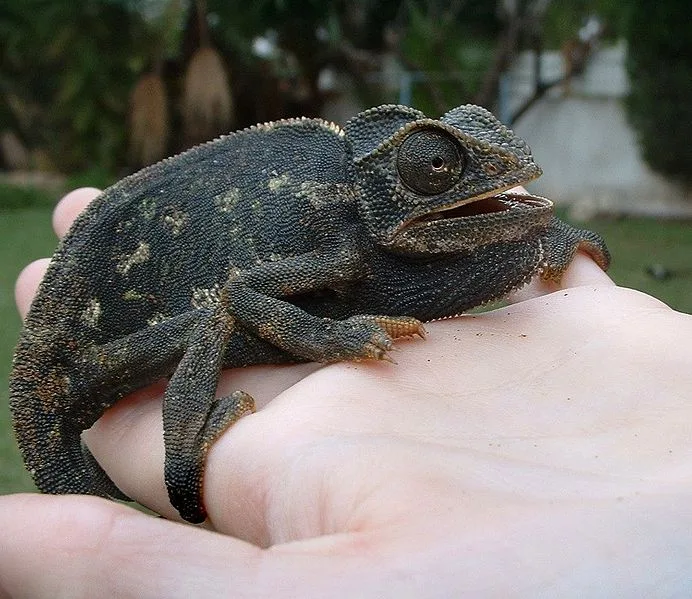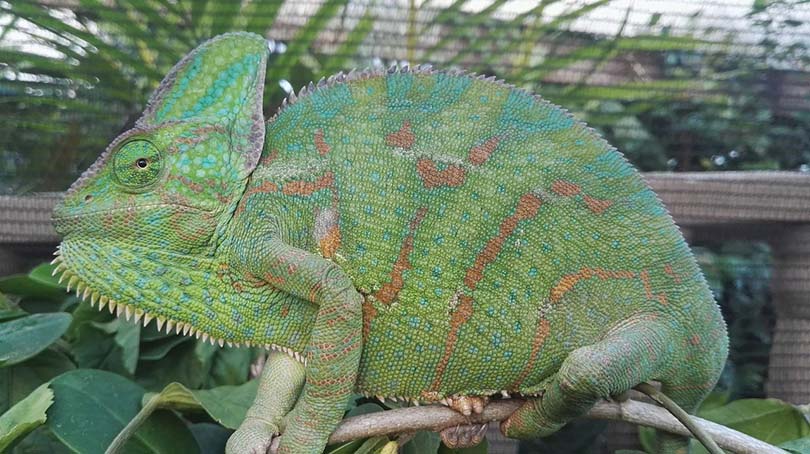What Do A Chameleon’S Colors Mean

Chameleons are well-known for their ability to change colors. But what do those colors mean? It turns out that chameleons use color for a variety of purposes, from communication to camouflage.
Here’s a closer look at what a chameleon’s colors can signify.Most people know that chameleons can change colors. What many don’t realize is that these reptiles use color for a variety of purposes, from communication to camouflage.
Let’s take a closer look at the meaning behind a chameleon’s colors.For starters, it’s important to understand that not all chameleons change color in the same way. Some species, like the Flap-necked Chameleon, have cells called chromatophores that allow them to alter their appearance.
Others, like the veiled chameleon, have special pigment cells that produce different hues.
A chameleon’s colors can mean a few different things. Most of the time, a chameleon will change its color in order to blend in with its surroundings. This helps the chameleon to avoid predators, and to find food more easily.
Sometimes, a chameleon will also change its color as a way of communicating with other chameleons. For example, a male chameleon might turn bright colors in order to intimidate other males or attract females. A female might turn darker colors when she is ready to lay eggs.
Chameleons can also change their colors as a response to temperature changes or stress levels. If it gets too cold, a chameleon might turn lighter colors in order to absorb more heat from the sun. If it gets too hot, the chameleon might turn darker colours so that it doesn’t overheat.
Chameleon Colors
Chameleons are one of the most interesting creatures in the world. They have the ability to change their colors in order to camouflage themselves from predators or to attract mates. But how do they do it?
The cells in a chameleon’s skin contain pigments, which are what give the lizard its color. When a chameleon wants to change its color, it will alter the amount of pigment in its cells, causing the cells to expand or contract. This change in size alters the way light is reflected off of the cells, and results in a different color being seen.
Interestingly, chameleons don’t just change their colors for camouflage or mating purposes. They also use color changes as a way to communicate with other chameleons. For example, a chameleon that is feeling threatened may turn black or dark brown as a way of saying “back off.”
If you’ve ever seen a chameleon changing colors, it’s truly an amazing sight!
Chameleon Color Change
Chameleons have the ability to change their colors in order to blend in with their surroundings. This color change is controlled by special cells in the chameleon’s skin called chromatophores. The chromatophores contain pigments that can be expanded or contracted, depending on the amount of light that is hitting them.
When a chameleon wants to appear darker, it will expand its chromatophores and when it wants to appear lighter, it will contract them.The color change is not just for camouflage purposes; it also plays a role in thermoregulation and communication. For example, a chameleon that is trying to attract a mate may display bright colors, while one that is feeling threatened may display dark colors.
So how does this all work? It’s actually pretty fascinating…The cells that make up the chameleon’s skin are layered on top of each other and each layer has a different purpose.
The bottom layer is made up of pigment cells called melanocytes which produce black or brown pigments. Above the melanocytes are three layers of iridophore cells which reflect light back through the melanocytes giving the chameleon its coloration. And finally, on top of all this are the chromatophore cells which we mentioned before – these are responsible for the color changes.
When light hits the chameleon’s skin, it first passes through the clear outer layer and then through the three layers of iridophore cells before reaching the chromatophore cells. The amount of light that makes it through to the chromatophores determines how much they will expand or contract and therefore how dark or light the chameleon will appear.
What Color Do Chameleons Turn When They are Happy
Chameleons are one of the most fascinating creatures on the planet. They have the ability to change their color in order to camouflage themselves from predators or to communicate with other chameleons. But what many people don’t know is that chameleons can also change color based on their mood.
So, what color do chameleons turn when they are happy? It has been observed that when chameleons are happy, they tend to turn a brighter shade of green. This is believed to be a way for them to signal to others that they are content and not in any danger.
If you ever have the chance to see a chameleon in person, take notice of its color. If it is a bright green, chances are good that it is feeling happy at that moment!
Chameleon Brown Color
Most people are familiar with the standard brown color that chameleons typically display. However, did you know that there is actually a wide range of different brown colors that chameleons can exhibit? In fact, some experts believe that there may be as many as 25 different shades of brown!
The exact color of a chameleon’s skin depends on a variety of factors, including their species, age, and even their mood. For example, younger chameleons tend to be more brightly colored than older ones. And if a chameleon is feeling threatened or aggressive, it will usually display darker colors.
Interestingly, the brown coloration found on most chameleons isn’t actually produced by their skin pigment. Instead, it’s created by special cells called iridophores which reflect light in such a way that it appears brown. So why do chameleons have this ability?
Well, one theory is that it helps them to blend in with their surroundings and avoid predators. Another possibility is that it allows them to regulate their body temperature by absorbing or reflecting heat from the sun. Whatever the reason, there’s no doubt that these amazing creatures are true masters of disguise!
What Does It Mean When a Chameleon Turns Yellow
When a chameleon turns yellow, it typically means that the animal is either sick or stressed. In some cases, however, a yellow chameleon can also be an indication of a lack of vitamin A in the diet. If you notice your chameleon turning yellow, it’s important to take him to the vet for a checkup to rule out any health problems.
If the vet finds that your chameleon is healthy, you may need to adjust his diet to ensure that he’s getting enough vitamin A.

Credit: petkeen.com
What Color is a Chameleon When It’S Happy?
When a chameleon is happy, its color can range from bright green to yellow.
What Does a Chameleon Changing Color Mean?
A chameleon’s color change is a form of camouflage. The lizard can match its surroundings, making it harder for predators to spot it. The color change is also used to communicate with other chameleons.
For example, a male chameleon will often turn black when he wants to mate.
What Determines the Color of a Chameleon?
Chameleons are well-known for their ability to change colors, but what determines the color of a chameleon? Chameleons can change colors for a variety of reasons, including camouflage, communication, and temperature regulation.The cells that allow chameleons to change colors are called chromatophores.
These cells contain pigments that reflect different wavelengths of light, resulting in different colors. When a chameleon wants to change colors, it sends signals to the chromatophores telling them to expand or contract. This exposes more or less of the pigment, resulting in a change in color.
Chameleons typically have three types of chromatophores: yellow/orange xanthophylls, red erythrophils, and brown melanophils. By expanding or contracting these chromatophores, chameleons can create a wide range of colors, from bright greens and yellows to more subdued browns and grays.So why do chameleons need to change colors?
One reason is camouflage. By matching the color of their surroundings, chameleons can avoid being seen by predators or prey. Another reason is communication.
In some species of chameleon, males will display bright colors when they are trying to attract mates while females tend to be more drab when they are not interested in breeding. Finally, changing color can help regulate body temperature.
What Color Should My Chameleon Be?
There is no one definitive answer to this question as it depends on several factors. Some chameleons are naturally more colorful than others, and the color of your chameleon may also depend on its diet and environment. If you are looking to add some color to your chameleon’s appearance, you can try feeding it colorful fruits and vegetables or placing it in a brightly lit area.
What are the differences between a fancy bearded dragon and a regular bearded dragon?
When comparing a fancy bearded dragon to a regular bearded dragon, there are a few noticeable fancy bearded dragon differences. Firstly, fancy bearded dragons typically have more vibrant and unique color patterns, making them visually striking. Additionally, fancy bearded dragons often have more elaborate scale formations and might exhibit different behaviors compared to regular bearded dragons. Overall, the fancy variant offers a unique and eye-catching option for pet owners interested in these reptiles.
How Do Chameleons Change Color?
Conclusion
Chameleons are known for their ability to change colors, but have you ever wondered what those colors mean? While it’s true that chameleons use color to help them blend into their surroundings, they also use color to communicate with other chameleons. For example, a chameleon who is feeling threatened may turn black or dark brown as a way of saying “back off.”
On the other hand, a chameleon who is looking for a mate may turn bright green or yellow.So, the next time you see a chameleon changing colors, take a moment to think about what it might be trying to say.